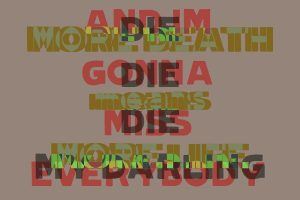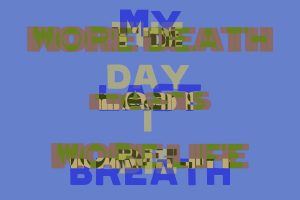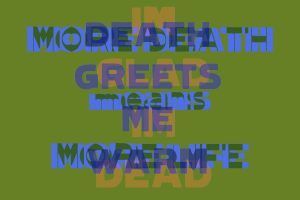by Nickolas Calabrese
 1. “…And I, who timidly hate life, fascinatedly fear death.” Fernando Pessoa, The Book of Disquiet.
1. “…And I, who timidly hate life, fascinatedly fear death.” Fernando Pessoa, The Book of Disquiet.
2. I didn’t ask to be born, yet I’ve been condemned to death. Early on in Plato’s Phaedra, Socrates declares that it’s the job of the philosopher to prepare for death. Addressing Simmias and Cebes he states, “I am afraid that other people do not realize that the one aim of those who practice philosophy in the proper manner is to practice for dying and death.” There is something vulgarly sunny in the way he suggests it, but it also rings clearly true. What philosophers talk about when they talk about ‘the good life’ is a life not regretted when it comes time to exit it. Theirs is the pursuit of truth and understanding, and our own mortality could not be a more present topic to pursue.
3. Quite a few artists are engaged in a similar investigation. Although theirs is not as pure as the philosophers’, the good ones have a strong tendency to make work that both eviscerates vanity and frames mortality. By its very nature, the subject becomes the object. The countless examples of musicians, artists, poets, etc., examining the finitude of their own lives constitutes a vast list. Those who have spent time producing work in this vein are legion: from Bob Dylan to Future, from John Donne to Amiri Baraka, from Cady Noland to Andy Warhol. It comes as no surprise that one’s own death is an attractive topic. After all it’s something that every person ever has either done or will do in their lives. Death is more common than emotions. Not all people are capable of, say, love, but everyone must die. But what artists try to do with their work is antithetical to what Socrates was defining: artists are trying to cheat death. I’ll say more about this further down.
4. The work of art that takes the artist’s mortality as its subject can be traced at least back to the tradition of the memento mori, which is a lodestar for the artist who thinks about how to live and die virtuously; being more or less a matter of salvation. Now, you can probably interject that these artists are simply making work about death generalized and not about their own. It might be true, but there is a strange fact about death that does not ring true for other topics. You can make art about love that is informed by your own experience in love. You can make art about violence against black men by police in the US informed by your own experience as a black person in the states. You can make art about a lot of things, often informed by your experiences with them (and sure you can make artworks about things you know nothing about, but that will in all likelihood be a shitty artwork). But nobody who is making anything has experienced death. And of course we might all have experienced deaths of friends, family, strangers in our presence, but then we are confronted with the fact of the above instances. If you’ve never been in love but you’ve seen people in love, does that qualify you to make an informed piece about it? Maybe, maybe not. The idea here is that an artist, like anyone, is concerned with their own death, not yours, whoever you may be.
 5. However, the artist approaches their death as a subject for a less noble reason than Socrates. I think that the artist makes work about death out of a sincere sense of anxiety, whether or not they admit it. Anxiety about death is a normative feature of being a person in general. Death = Undesirable. It is an uncontroversial statement that this is how a lot of people feel. Of course there are those who commit suicide (frequently owed to mental health disorders like depression), but that is a matter of a brain that isn’t functioning as it ought to. And then there are those who look at life as just a precursor for the afterlife. Counting among its ranks most religious persuasions, but as I understand it very few are actively attempting to end their lives prematurely in order to reach the afterlife. Whether manifest or subconscious, most people do not actively seek out actual death. Of course we seek simulations, like roller coasters or role playing exercises predicated on dangerous activities that are safeguarded to ensure that nobody gets hurt (think BDSM and video games alike). I should rather have said that avoiding death is a normative condition of living life. Because, really, it is very easy to end life if one chooses. It’s actually more difficult to stay alive than to become dead.
5. However, the artist approaches their death as a subject for a less noble reason than Socrates. I think that the artist makes work about death out of a sincere sense of anxiety, whether or not they admit it. Anxiety about death is a normative feature of being a person in general. Death = Undesirable. It is an uncontroversial statement that this is how a lot of people feel. Of course there are those who commit suicide (frequently owed to mental health disorders like depression), but that is a matter of a brain that isn’t functioning as it ought to. And then there are those who look at life as just a precursor for the afterlife. Counting among its ranks most religious persuasions, but as I understand it very few are actively attempting to end their lives prematurely in order to reach the afterlife. Whether manifest or subconscious, most people do not actively seek out actual death. Of course we seek simulations, like roller coasters or role playing exercises predicated on dangerous activities that are safeguarded to ensure that nobody gets hurt (think BDSM and video games alike). I should rather have said that avoiding death is a normative condition of living life. Because, really, it is very easy to end life if one chooses. It’s actually more difficult to stay alive than to become dead.
6. So why is something so easy to achieve and so common in the history of the world (everybody has died or will die at some point) so intriguing to so many artists? We all have considered our deaths, whether in that moment when you were almost hit by a car, or when you’d taken a bit too much acid and felt like you might melt into a puddle on the couch. This fascination comes with the assurance that it will absolutely happen, just not now (hopefully). One of the most peculiar distinctions to be made about death is that it might not actually exist in the way we nominally think of it. Epicurus, for one, thought that to be afraid of death was absurd, since death was not an event; there’s no before and after. Since you cease to exist when you die, there is nothing to be afraid of, because you cannot experience what death consists of. And while you are alive, death has not harmed you. It’s not an excellent argument, but it shows a good way to frame what is at stake: our future non-existence.
7. Following in Epicurus’ footsteps, Lucretius tried to provide a better account of the absurdity of death. Employing the “symmetry argument”, he wonders why we aren’t full of dread for the time before we were born, as we also did not exist in that moment. Logically, for Lucretius, if we fear the time we will cease to exist, we should also fear the time prior to our existence, because it is characterized by the same state of personhood, which is nonexistence. While his account is also persuasive, it is not quite satisfactory. I don’t think it is our nonexistence that people fear in general when they fear death. It is more the mystery of it all. What it will feel like to slip away from life itself, to go from everything to nothing. Will it hurt? Will there turn out to be a religious afterlife? Will I feel my essence ooze into the ether? Will I be bored? Will it be exciting? Will I see it coming or will it surprise me on a Tuesday afternoon while sipping a chai latte with almond milk?
8. Artists are invested in making things that do not exist. Otherwise they would be designers. This might be a premature thought, but that could be the primary distinction between artists and designers: designers make things for living, artists make things for dying. How does one prove that artists make things for dying? I think that there are several ways to explain this. For one, artworks have no practical purpose, no use. They did not exist before the artist invented them, and their furthered existence will be spent trying not to deteriorate (in museum collections, private collections, etc.). Furthermore, it seems that artists consider death in a structural way. What do I mean by structural? Well I mean that death provides the architecture through which we approach life. Thinking about one’s death naturally raises the question of how one has lived, just as Socrates was implying. It offers a framework against which we can enact a sort of retrospective look on our life from a point in time that has yet to come. In a way, making art about one’s own death is time travelling to some counterfactual future and back again.
9. Perhaps the more convincing argument to make about artists and death, is that they make artworks to cheat death in some perverse way. By making something that has a potentially large value, they are gilding their life and their reputation for a duration as long as the artwork exists. Similar to the ancient Egyptian model of being buried with jewels and gold and ornamentation of all sorts, artists seem to carry with them a desire to have their touch exist long after their death. Indeed, we are all still quite familiar with Da Vinci and Matisse. Every time one sees the works of a great master, like Caravaggio’s portraits of St. Matthew, they are struck by what Benjamin famously called it’s “aura”. The aura is the last bit of life left in the work, imparted by the artist as if through magic (think of the Horcruxes from the Harry Potter series).
 10. Now, aesthetically, what do these artworks look like? I don’t know. But I want to assure the reader that when I say artworks about death I do not mean a drawing made by the artist of their own literal death, like being struck by a taxi while crossing the street during rush hour traffic. Artworks about one’s death can look like just about anything (and this is obviously true for any artwork – metaphors, duh). A good example would be Cady Noland’s silkscreens on aluminum, which, according to her, contained the seeds of her deepest fears. But to the naïve eye they look like a beguiled preoccupation with news headlines. The things that most effectively propel us as agents in the world are either the things that we desire or the things that are anathema to our existence. We have a fixation on considering what we want our lives to be about or not about. In other words, we think about our death and worry about it with the expectation that it will help us to live the life we have. If death is a pressing subject, then we can attempt to have a fuller life as a result.
10. Now, aesthetically, what do these artworks look like? I don’t know. But I want to assure the reader that when I say artworks about death I do not mean a drawing made by the artist of their own literal death, like being struck by a taxi while crossing the street during rush hour traffic. Artworks about one’s death can look like just about anything (and this is obviously true for any artwork – metaphors, duh). A good example would be Cady Noland’s silkscreens on aluminum, which, according to her, contained the seeds of her deepest fears. But to the naïve eye they look like a beguiled preoccupation with news headlines. The things that most effectively propel us as agents in the world are either the things that we desire or the things that are anathema to our existence. We have a fixation on considering what we want our lives to be about or not about. In other words, we think about our death and worry about it with the expectation that it will help us to live the life we have. If death is a pressing subject, then we can attempt to have a fuller life as a result.
11. Certainly this is not always the case, and it might even prove to be infrequently the case. But I believe that the best of art enacts these relationships meaningfully. Thomas Nagel wrote an insightful brief essay about death called “Death”, and it points to something that I think a lot of artists subconsciously disagree with. In speaking about the loss of life, Nagel notes that there is an important asymmetry, where, for instance, we can speak of one person who lived to 78 as having more life than someone who died prematurely in a car accident at the age of 23. But Nagel notes that we cannot ascribe the same quantification of having more or less death. He says, “If it is good to be alive, that advantage can be attributed to a person at each point of his life. It is a good of which Bach had more than Schubert, simply because he lived longer. Death, however is not an evil of which Shakespeare has so far received a larger portion than Proust.” I would argue that, in a way, some people, artists especially, make work considering this idea of more or less death.
12. The manner of which I mean having “more death” is of course different than the literal sense that Nagel is speaking against. When I think of more death, I think of having the courage to make work that confronts mortality and a life lived more directly and more fervently, like someone of Noland’s caliber. More death is simply more understanding of what’s at stake. It’s an approach that provides the artist with that structural way of considering life through its finitude that I pointed to above. The good philosopher practices death and the good artist cheats death.
13. “And I’m gonna miss everybody/and I’m gonna miss everybody/when I’m gone.” Bone Thugs-N-Harmony.
